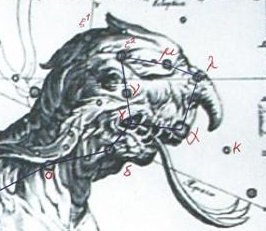From observing the nakshatra position of Spica and Alcor
at the great vero with a great dot in front (Cb8-6) it seems
likely that the nakshatra perspective should be used when
'reading' the glyphs.
This idea can perhaps be supported by Nash (γ
Sagittarii) at Cb10-18, because I think 18h and December
20 (354) should be a better motive for te tagata than
June 22:
|
June 17 |
18 (169) |
19 |
20 |
solstice |
22 |
 |
 |
 |
 |
 |
 |
|
Cb10-13 |
Cb10-14 |
Cb10-15 |
Cb10-16 |
Cb10-17 |
Cb10-18 (640) |
|
te moa nui -
kua vaha |
te hokohuki-
te mata |
te matagi ma
te rau hei |
te hokohuki -
te moko |
te kava - te
hokohuki |
te kihikihi i
te rima o te tagata |
|
Wezn
(87.6), δ Leporis (87.7), Tze
(87.9),
BETELGEUZE (88.3),
ξ Columbae (88.5) |
σ
Columbae
(88.7), η Leporis
(89.0),
Praja-pāti,
Menkalinan, Mahashim,
γ Columbae (89.3)
|
η
Columbae (89.7), μ Orionis
(90.3) |
6h (91.3) |
π
Columbae (91.6), ξ Orionis
(92.5) |
Tejat Prior (93.4) |
Zuben Elgenubi 533 |
ν Orionis (91.4), θ Columbae
(91.5) |
|
December 15 |
16 |
17 |
18 |
19 |
20 (354) |
|
Kew Ho (268.6), η Pavonis
(268.7), Apollyon (268.9),
Muliphen (269.0), Basanismus
(269.5) |
Pherkard
(269.9), Ptolemy Cluster (270.5) |
Rukbalgethi Genubi (271.1), ξ
Herculis (271.5) |
Etamin, ν Herculis (271.7), ν
Ophiuchi (271.8), ζ Serpentis
(272.4) |
τ Ophiuchi (272.9) |
18h (273.9) |
|
NASH (273.7), θ Arae (273.8),
Zhōngshān (274.0) |
|
St John's Eve |
St John's day |
June
25 |
26 (177) |
 |
 |
 |
 |
|
Cb10-19 |
Cb10-20 |
Cb10-21 |
Cb10-22 |
|
te
hokohuki - manu rere |
te
kihikihi o te marama |
te maro o
te henua |
kua vero |
|
κ
Aurigae (93.6), κ Columbae
(93.8) |
Furud (94.9), δ Columbae
(95.2),
TEJAT POSTERIOR,
Mirzam (95.4) |
Canopus (95.6),
ψ1 Aurigae (95.9) |
no star listed |
|
solstice |
22 |
23 |
X-mas Eve (358) |
|
π Pavonis (274.6), ι Pavonis
(275.1) |
Polis (275.9) |
η Sagittarii (276.9),
Kaus
Medius, κ Lyrae (277.5) |
Tung Hae (277.7),
KAUS
AUSTRALIS (278.3), ξ Pavonis
(278.4) |
Menkar 720 |
Ihe tau at
left in Cb10-19 (where 19 alludes to
the Sun) and manu rere with
a very long 'snout' at right seems
more reasonable at the solstice than in June 23.
The very long snout could refer to
that of the Sea Beast, marked by
Menkar (α):

South
of the equator all is upside down and a Sea Beast becomes an Air
Creature.
But more convincing is the position of Nash
in the Chinese structure, 71 days after Spica:
|
1 |
Horn |
α
Virginis (Spica) |
Crocodile |
(202.7) |
Oct 10
(283) |
283 =
265
+ 18 |
|
2 |
Neck |
κ
Virginis |
Dragon |
(214.8) |
Oct 22
(295) |
295 =
283
+ 12 |
|
3 |
Root |
α Librae
(Zuben Elgenubi) |
Badger |
(224.2) |
Oct 31
(304) |
304 =
295
+ 9 |
|
4 |
Room |
π
Scorpii (Vrischika) |
Hare |
(241.3) |
Nov 17
(321) |
321 =
304
+ 17 |
|
5 |
Heart |
σ
Scorpii |
Fox |
(247.0) |
Nov 23
(327) |
327 =
321
+ 6 |
|
6 |
Tail |
μ
Scorpii (Denebakrab) |
Tiger |
(254.7) |
Dec 1
(335) |
335 =
327
+ 8 |
|
7 |
Winnowing Basket |
γ
Sagittarii (Nash) |
Leopard |
(273.7) |
Dec 20
(354) |
354 =
335
+
19 |
There are 100 days from Nash (Cb10-18) to the end of side b.
8 *
8 * 10¹ = 640 = 740 - 100.
The Winnowing Basket is evidently the
end station when counting 12 lunar synodic months from
January 1.
"Alnasl
is derived from the Arabic... al-naşl meaning
'arrowhead', Nushaba is derived from the Arabic
Zujj al-Nashshaba meaning the same as Alnasl.
Warida is derived from ... Al Na'ām al Wārid, the
Going Ostriches, the asterism consisting [of] this star [was
including] δ Sgr, ε Sgr and η Sgr." (Wikipedia)

Corona Australis is depicted upside down,
which probably is a Sign to indicate that the arrow has hit
its mark..
|









